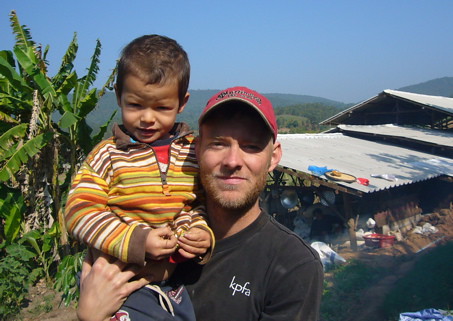Friday, December 29, 2006
Thai medical system: Two thumbs up
Well, this morning I had an encounter with a piece of sheet metal that almost cost me a thumb. After a bout of wooziness I jumped on the moped behind Pi Jo and headed for the medical clinic in the next village over.
The nurse cleaned up the cut, hit me off with some novicaine and sewed it up with half-a-dozen or so stitches. They whole procedure, from the moment I walked in the door, couldn't have taken more than twenty minutes. And the cost? 20 Baht: about $0.60.
So it turns out that Thailand has a very efficient and cheap medical system! Pi Jo said people from the US, Australia and Wester Europe turn up all the time to get medical procedures that are too expensive in their countries. Apparently the hospitals are very nice, patients are treated like royalty, and the costs extremely affordable.
My experience at the clinic here was so great compared to the likely 5 hours I would have spent in the ER in Oakland, and the $700 it would have cost me.
And ladies, if you're thinking about reproducing...Peggy got the full-on, top-of-the-line obstetrics and maternity treatment at Thai hospital for about $200 when she had Tahn.
The nurse cleaned up the cut, hit me off with some novicaine and sewed it up with half-a-dozen or so stitches. They whole procedure, from the moment I walked in the door, couldn't have taken more than twenty minutes. And the cost? 20 Baht: about $0.60.
So it turns out that Thailand has a very efficient and cheap medical system! Pi Jo said people from the US, Australia and Wester Europe turn up all the time to get medical procedures that are too expensive in their countries. Apparently the hospitals are very nice, patients are treated like royalty, and the costs extremely affordable.
My experience at the clinic here was so great compared to the likely 5 hours I would have spent in the ER in Oakland, and the $700 it would have cost me.
And ladies, if you're thinking about reproducing...Peggy got the full-on, top-of-the-line obstetrics and maternity treatment at Thai hospital for about $200 when she had Tahn.
Sunday, December 24, 2006
A Lahu Christmas Story
Last night, Christmas Eve, Pun Pun resident Pi Jeni's entire hill tribe village came over for Christmas caroling. The Lahu, like many hill tribes, are Christians. They were converted by missionaries so long ago that no one can remember not being Christian -- I'm guessing at least 150 years (?)
The Lahu have their own dialect and most do not speak Thai, so Pi Jeni had to translate Lahu to Thai, which Pi Jo then translated to English for us Westerners.
We sang songs from their Christian songbook -- it resembles a Hymnal with the lyrics transliterated to Roman script. So we sang along with them Silent Night, It Came Upon a Midnight Clear, and other Christmastime favorites in their dialect to the familiar tunes. Then the young Lahu girls, in their traditional dress, did some song and dance and interpretive hand motions for us -- they were so cute!
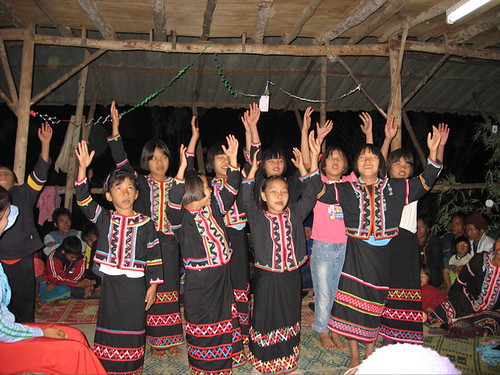
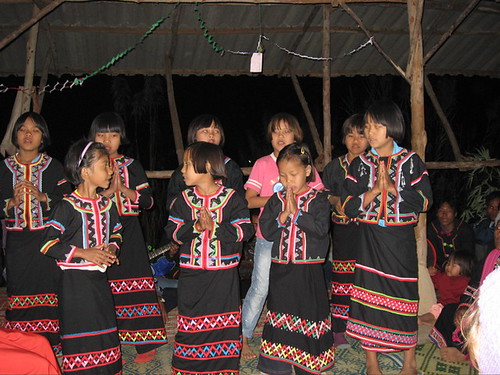
After the singing we all shook hands and the Lahu left to continue caroling around the village.
The Lahu have their own dialect and most do not speak Thai, so Pi Jeni had to translate Lahu to Thai, which Pi Jo then translated to English for us Westerners.
We sang songs from their Christian songbook -- it resembles a Hymnal with the lyrics transliterated to Roman script. So we sang along with them Silent Night, It Came Upon a Midnight Clear, and other Christmastime favorites in their dialect to the familiar tunes. Then the young Lahu girls, in their traditional dress, did some song and dance and interpretive hand motions for us -- they were so cute!


After the singing we all shook hands and the Lahu left to continue caroling around the village.
Ginger beer
In our continued experiments with fermentation we have begun a batch of ginger beer. The recipe was taken from the excellent book, “Wild Fermentation” by Sandor Katz.
The starter is called the “ginger bug” and is made by adding a few tablespoons of grated ginger root (skin and all) to a few tablespoons of raw cane sugar in about 1 cup of water. This is left covered with cheesecloth in a warm spot for about a week. Each day we add a similar amount of ginger and sugar, until the bug starts bubbling.
To make the beer, we boil 2 liters of water containing 6 inches of grated ginger root and 1.5 cups of sugar for about 15 minutes. This mixture is then cooled and the solid material strained out. To the remainder we add lemon juice and the ginger bug, and water to one gallon final volume. This is sealed up and allowed to ferment for about 2 weeks.
The resulting “beer” is carbonated but not alcoholic.
The starter is called the “ginger bug” and is made by adding a few tablespoons of grated ginger root (skin and all) to a few tablespoons of raw cane sugar in about 1 cup of water. This is left covered with cheesecloth in a warm spot for about a week. Each day we add a similar amount of ginger and sugar, until the bug starts bubbling.
To make the beer, we boil 2 liters of water containing 6 inches of grated ginger root and 1.5 cups of sugar for about 15 minutes. This mixture is then cooled and the solid material strained out. To the remainder we add lemon juice and the ginger bug, and water to one gallon final volume. This is sealed up and allowed to ferment for about 2 weeks.
The resulting “beer” is carbonated but not alcoholic.
Thursday, December 21, 2006
Grafting and cloning
This morning we had a lesson from Pi Jo on grafting and cloning trees and shrubs. Grafting is a clever technique where you can get one fruit tree, say a mango or apple tree, to produce several different varieties of fruit. This is done by grafting a shoot from the desired variety onto a healthy trunk.
Jo recommends growing up a wild mango tree from seed. These trees grow very well, make strong trees and require little maintenance since the wild conditions have selected for a hearty plant. However, wild mango fruits are not as nice as many other varieties.
Here we are grafting a shoot from a very beautiful and tasty mango variety onto a well-established wild-type tree.
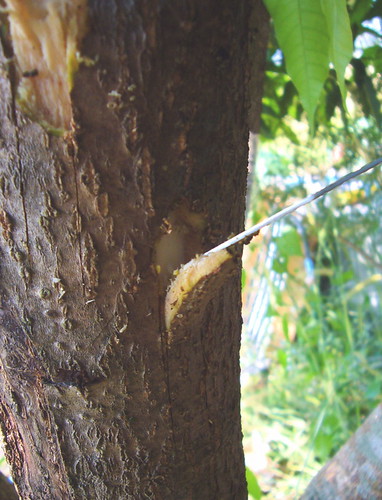
First you make an arrow-shaped incision into the bark just a little wider than the shoot and 2 – 3 inches long. Cut and peel away a section of the bark.
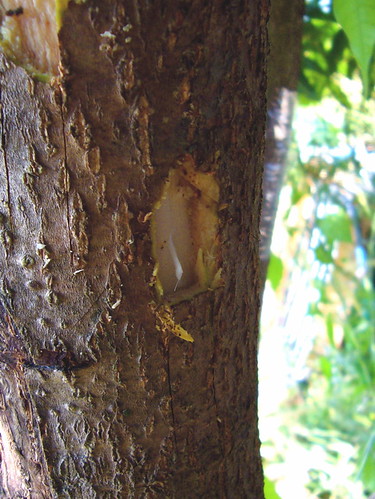
Then trim the shoot to expose its insides and insert it between the wood and the bark of the host tree.
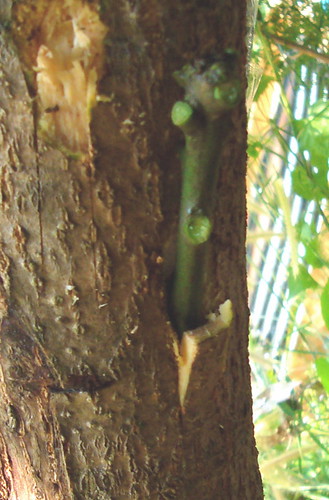
Wrap the whole thing with non-sticky tape or plastic to keep the sap from drying out.
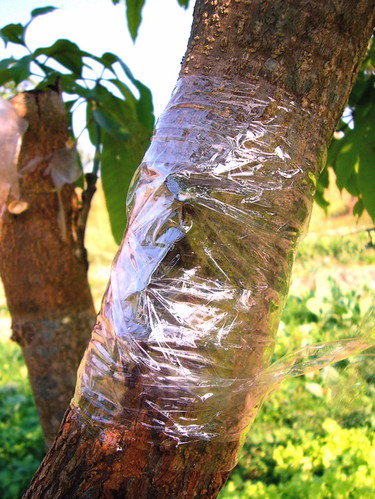
In a few weeks, some new shoots will appear – cut the tape then to let the shoots grow. The new shoot will flower in the first year; however, the flowers should be removed so that no fruit forms while the graft is too small to hold the fruit. By the second year it should be bearing fruit successfully.
Pi Jo also showed us a technique called layering which can be used to clone trees and shrubs and generate fruit or berries very quickly. Here we are reproducing a mulberry bush. (We can grow as many mulberries as we want since Tahn will eat them ceaselessly.) The bark is removed from about 2 inches of an intermediate-aged branch.
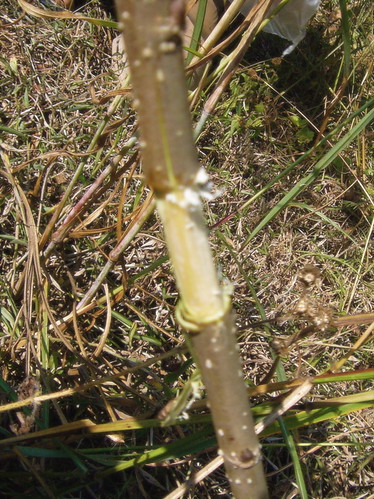
A handful of soil is then applied to the branch and held in place with plastic.

Within two weeks roots will begin to grow from the exposed branch into the dirt. Then the branch can be cut off and planted – it will grow into a bush and produce berries of the same appearance and quality as the plant from which it was taken.
Both of these techniques are used on ornamental plants as well, such as roses, where the desire is to control the attributes of the flowers or to grow multiple colors of flowers from one plant.
Jo recommends growing up a wild mango tree from seed. These trees grow very well, make strong trees and require little maintenance since the wild conditions have selected for a hearty plant. However, wild mango fruits are not as nice as many other varieties.
Here we are grafting a shoot from a very beautiful and tasty mango variety onto a well-established wild-type tree.

First you make an arrow-shaped incision into the bark just a little wider than the shoot and 2 – 3 inches long. Cut and peel away a section of the bark.

Then trim the shoot to expose its insides and insert it between the wood and the bark of the host tree.

Wrap the whole thing with non-sticky tape or plastic to keep the sap from drying out.

In a few weeks, some new shoots will appear – cut the tape then to let the shoots grow. The new shoot will flower in the first year; however, the flowers should be removed so that no fruit forms while the graft is too small to hold the fruit. By the second year it should be bearing fruit successfully.
Pi Jo also showed us a technique called layering which can be used to clone trees and shrubs and generate fruit or berries very quickly. Here we are reproducing a mulberry bush. (We can grow as many mulberries as we want since Tahn will eat them ceaselessly.) The bark is removed from about 2 inches of an intermediate-aged branch.

A handful of soil is then applied to the branch and held in place with plastic.

Within two weeks roots will begin to grow from the exposed branch into the dirt. Then the branch can be cut off and planted – it will grow into a bush and produce berries of the same appearance and quality as the plant from which it was taken.
Both of these techniques are used on ornamental plants as well, such as roses, where the desire is to control the attributes of the flowers or to grow multiple colors of flowers from one plant.
Charcoal and wood vinegar
Here we are making charcoal and wood vinegar. These are both very useful materials and easy to obtain.

Charcoal has a multitude of uses, for example it is an excellent cooking fuel since it produces very little smoke for the amount of heat that it emits (and since many Asian people cook over a fire indoors, indoor air pollution can be a big problem). It can be ground up and added to soap to provide a gritty quality that’s good for scrubbing. Some Thai religious groups make and sell fruits and flowers baked into charcoal that are decorative and are used to absorb smells, like in your refrigerator. (Pi Jo says you can put a rose into the charcoal oven and it will come out completely intact – so you have a charcoal briquette that looks like a rose bloom.) And bamboo charcoal from the Kanchanaburi region of Thailand is sold all over the world for activated carbon used in water purifiers.
Wood vinegar is a by-product of charcoal making that also has several uses. It is a mild and non-toxic wood preservative – insects don’t like it so you can apply it to construction wood and it will keep the termites away. Also since insects don’t like it, it’s good for pest control in the garden. It can be diluted and added to compost as an activator, and has mild antiseptic properties that make it good for applying to cuts to encourage healing.
The way to make charcoal (and thus wood vinegar) is to burn a lot of wood with little oxygen. In this way it doesn’t really burn; rather, it bakes as the water and volatile organic compounds are driven off. The water and organics are condensed from the smoke and collected in liquid form – this is concentrated wood vinegar, which is diluted typically 1:1000 for application to plants, lumber, etc.
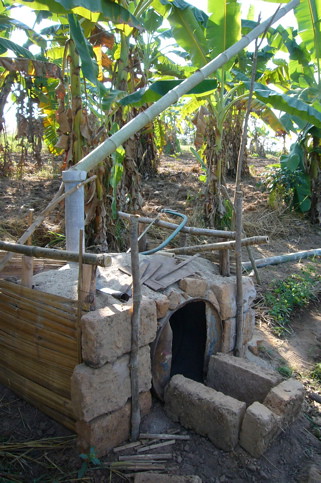
The apparatus we are using for a charcoal oven is an old discarded 55-gallon metal drum. The drum is laid on its side and insulated with adobe bricks and sand. We packed the drum full of cut wood and built a fire at the entrance of the drum. Smoke and heat are drawn by the long, slanting bamboo chimney into the drum. The fire at the opening of the drum is stoked for 1 – 2 hours, until the smoke coming out of the chimney changes from a thick darker smoke into a wispy, white smoke. The entrance of the drum is then sealed up with adobe bricks and mud.
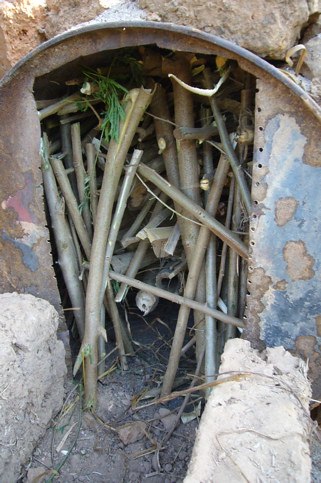

The smoke travels up the chimney and water containing uncombusted organic molecules condenses near the top – this is the wood vinegar, which is collected through a small notch near the base of the chimney. (The spoon helps the liquid to collect and drip into a bucket). This design with a bamboo chimney is the simplest, although more efficient collection can be achieved using a cold-water condenser around the chimney.
Burning one drum-full of wood yields 1 – 2 liters of wood vinegar.
Gradually over a few hours the smoke will become even lighter and wispier. At this point, wood vinegar collection is discontinued and the chimney is sealed up to allow the wood in the drum to finish turning into charcoal (an overnight process).
Rural Thai people have used wood vinegar for a long time, but Pi Jo says now Monsanto has moved in and begun to market a commercial, patented formula. It’s just like Monsanto to take some technique that people have been doing forever and patent it and sell it back to the people for a profit. Then people gradually forget how to do it and end up becoming dependent on Monsanto to supply them with something they used to be able to make for themselves.

Charcoal has a multitude of uses, for example it is an excellent cooking fuel since it produces very little smoke for the amount of heat that it emits (and since many Asian people cook over a fire indoors, indoor air pollution can be a big problem). It can be ground up and added to soap to provide a gritty quality that’s good for scrubbing. Some Thai religious groups make and sell fruits and flowers baked into charcoal that are decorative and are used to absorb smells, like in your refrigerator. (Pi Jo says you can put a rose into the charcoal oven and it will come out completely intact – so you have a charcoal briquette that looks like a rose bloom.) And bamboo charcoal from the Kanchanaburi region of Thailand is sold all over the world for activated carbon used in water purifiers.
Wood vinegar is a by-product of charcoal making that also has several uses. It is a mild and non-toxic wood preservative – insects don’t like it so you can apply it to construction wood and it will keep the termites away. Also since insects don’t like it, it’s good for pest control in the garden. It can be diluted and added to compost as an activator, and has mild antiseptic properties that make it good for applying to cuts to encourage healing.
The way to make charcoal (and thus wood vinegar) is to burn a lot of wood with little oxygen. In this way it doesn’t really burn; rather, it bakes as the water and volatile organic compounds are driven off. The water and organics are condensed from the smoke and collected in liquid form – this is concentrated wood vinegar, which is diluted typically 1:1000 for application to plants, lumber, etc.

The apparatus we are using for a charcoal oven is an old discarded 55-gallon metal drum. The drum is laid on its side and insulated with adobe bricks and sand. We packed the drum full of cut wood and built a fire at the entrance of the drum. Smoke and heat are drawn by the long, slanting bamboo chimney into the drum. The fire at the opening of the drum is stoked for 1 – 2 hours, until the smoke coming out of the chimney changes from a thick darker smoke into a wispy, white smoke. The entrance of the drum is then sealed up with adobe bricks and mud.


The smoke travels up the chimney and water containing uncombusted organic molecules condenses near the top – this is the wood vinegar, which is collected through a small notch near the base of the chimney. (The spoon helps the liquid to collect and drip into a bucket). This design with a bamboo chimney is the simplest, although more efficient collection can be achieved using a cold-water condenser around the chimney.
Burning one drum-full of wood yields 1 – 2 liters of wood vinegar.
Gradually over a few hours the smoke will become even lighter and wispier. At this point, wood vinegar collection is discontinued and the chimney is sealed up to allow the wood in the drum to finish turning into charcoal (an overnight process).
Rural Thai people have used wood vinegar for a long time, but Pi Jo says now Monsanto has moved in and begun to market a commercial, patented formula. It’s just like Monsanto to take some technique that people have been doing forever and patent it and sell it back to the people for a profit. Then people gradually forget how to do it and end up becoming dependent on Monsanto to supply them with something they used to be able to make for themselves.
Monday, December 18, 2006
Projects...
A (typical) beautiful day:
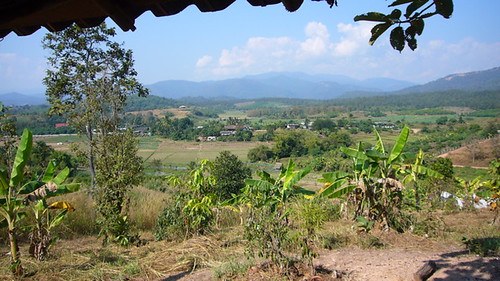
Things have been busy on the farm...
We have been building a stove and oven for the kitchen out of adobe and brick-and-mortar. Here are some photos of our progress:
The foundation for the stove

Check out that arch work!
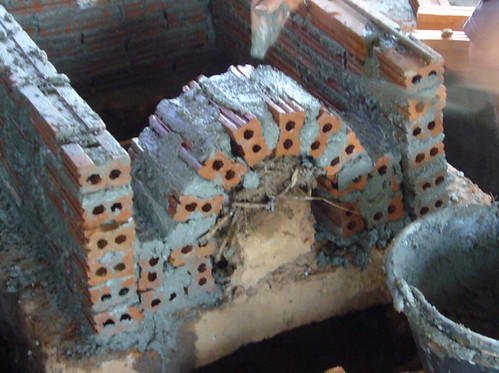

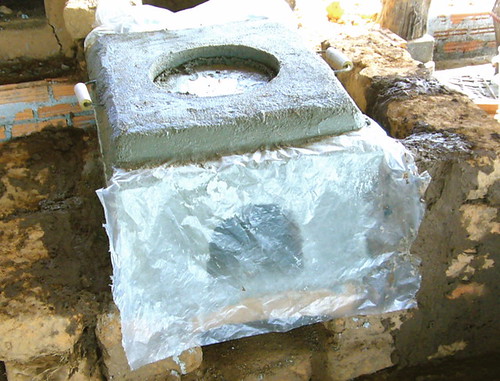
The stove nearing completion
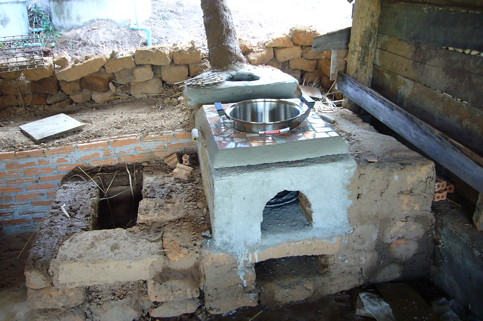
Check out that totally sweet tile work!

And the oven...

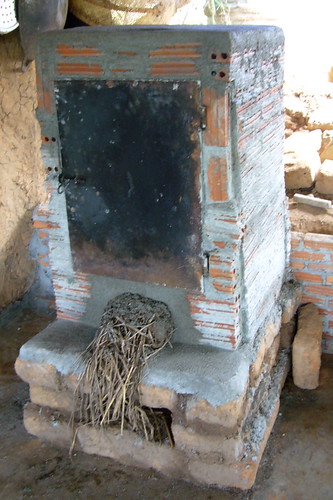
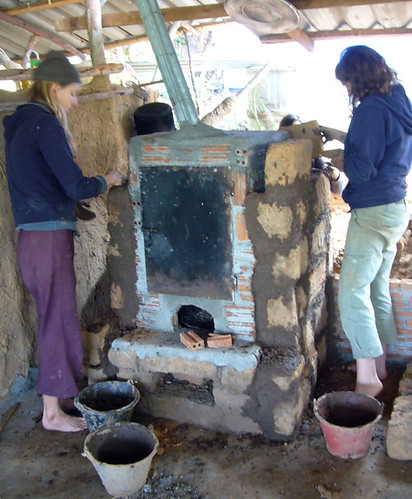
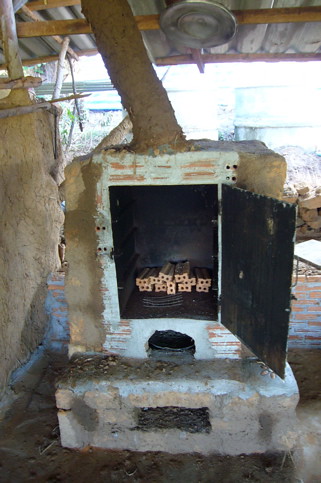
A trial run of the almost-finished oven...
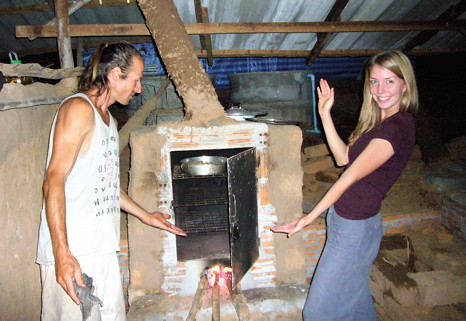
Brant is very excited about pizza!
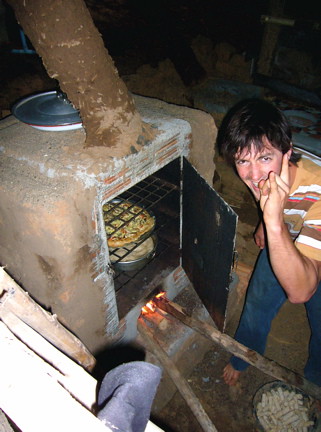
Tahn samples the product...
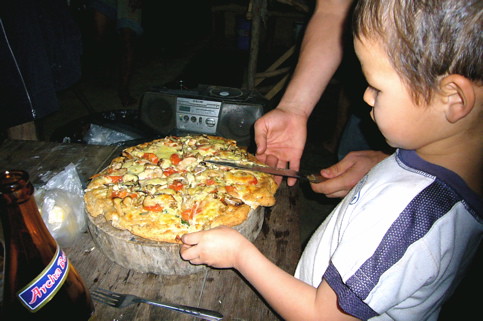
Growing shitake mushrooms...
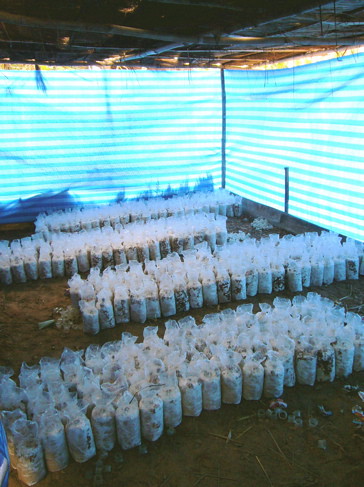

Planting tomatoes...
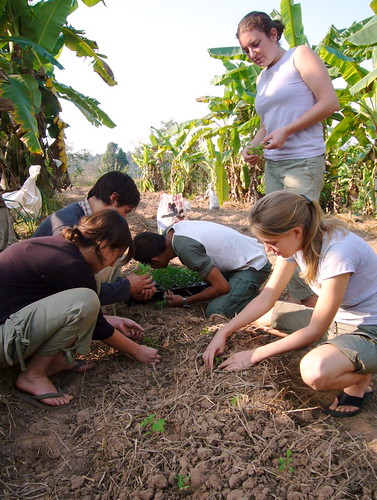
and getting aggro when it's time to cut bamboo from the forest!!!


Things have been busy on the farm...
We have been building a stove and oven for the kitchen out of adobe and brick-and-mortar. Here are some photos of our progress:
The foundation for the stove

Check out that arch work!



The stove nearing completion

Check out that totally sweet tile work!

And the oven...




A trial run of the almost-finished oven...

Brant is very excited about pizza!

Tahn samples the product...

Growing shitake mushrooms...


Planting tomatoes...

and getting aggro when it's time to cut bamboo from the forest!!!

Thursday, December 14, 2006
Adobe building
Pi Jo and Pi Dtai (pictured here, on the left) are world-renowned adobe builders. We have begun under their tutelage to make bricks that will comprise the yoga/meditation center. Here we are mixing mud with our feet...

The ingredients are clay, sand and water in the right proportions, to which we add a large amount of rice husks (a waste material) that provides fibers for strength and binding for the bricks.
We fill wooden forms with the mud, then remove the forms and let the bricks dry in the sun.
Hadar (left) amd Julia doing the form work.

We work every other day or so making bricks for 2 - 3 hours at a time. Our current rate is to produce about 100 bricks an hour, but Pi Jo promises to teach us his technique for making bricks even faster. The speed/efficiency is good since we need to make at least 4,000 or so for the yoga center!

The ingredients are clay, sand and water in the right proportions, to which we add a large amount of rice husks (a waste material) that provides fibers for strength and binding for the bricks.
We fill wooden forms with the mud, then remove the forms and let the bricks dry in the sun.
Hadar (left) amd Julia doing the form work.

We work every other day or so making bricks for 2 - 3 hours at a time. Our current rate is to produce about 100 bricks an hour, but Pi Jo promises to teach us his technique for making bricks even faster. The speed/efficiency is good since we need to make at least 4,000 or so for the yoga center!
Contact me!
Next week I will be available to talk over Skype from 8:30 PM on Monday evening (December 18) until 12:30 AM Tuesday (December 19), East Coast time, or from 5:30 PM until 9:30 PM Monday on the West Coast. My Skype name is joshkearns, if I am not already on your contacts list.
Also, if you’d like to write to me using conventional mail, my address is
Pun Pun Farm
PO Box 5
Mae Taeng, Chiang Mai 50150
Thailand
Also, if you’d like to write to me using conventional mail, my address is
Pun Pun Farm
PO Box 5
Mae Taeng, Chiang Mai 50150
Thailand
Self-reliance
With all due respect to Ralph Waldo Emerson...
Pun Pun’s philosophy can be succinctly conceptualized as a practical demonstration of self-reliance. I want to talk a bit out what is meant by this term “self-reliance,” partly because it is integral to what we are doing here and the kinds of transformation that Pun Pun is promoting in Thailand, but also because I think it is a very valuable concept for our well-being in the United States.
Last night Pi Jo gave a talk on his philosophical development and how his life experiences have led him to pursue and promote self-reliance as a way of life for himself, his community and his country. What follows are some notes from his talk interwoven with my own ideas about how the idea of self-reliance can be understood, expanded and practiced in the U.S. as well as Thailand.
Pi Jo grew up in a “poor” village in the northeast of Thailand, where, he says, “money was basically useless, since, even if anyone had money, which most did not, there was nothing to buy since there was no marketplace.”
Jo’s hometown is an agrarian village where people were and still are, though less so today than when Jo was a kid, self-reliant. Everyone had a garden, and people worked together in the rice fields to plant and harvest the rice. Jo said that people in his village worked for about two months out of the year – and this mainly involved cultivating rice. Work in the gardens required about 30 minutes a day. The rest of the time was for preparing food, working on crafts and projects, and free time.
Jo left the village as a teenager and moved to Bangkok, where he stayed for seven years. Here life was very hard since he spoke only a little Thai (his village speaks a different dialect), and it was hard to get a job. In Bangkok he worked eight- or twelve-hour days and made very little money. Often he went hungry. All around him he saw people stressed out and working very hard for money – usually too little money – which they would exchange in the market for some food, pay rent, etc.
Jo experienced a great internal conflict since he knew how easy and happy life was in his village, but he was afraid of what would happen to him, what people would think of him, if he left the city life in Bangkok and went back out to the forest. He had a transformational experience one day sitting by a river as he watched a butterfly sit comfortably and carefree on a long leaf of grass that was pushed about by the flowing river. “Why can’t I be happy and free like that butterfly? Why am I a slave in this city life?” he thought.
What Jo realized is that the so-called “modern” lifestyle has trapped many people and made them slaves. In the modern economy, people must work eight hours a day to get food, and for thirty years to get a house. Most jobs are like prison: working inside, staring at the clock, waiting for lunch break or time to go home. People come home from work exhausted and turn on the TV for mind-numbing “entertainment.” The TV mostly tells people that they are unhappy, that something is wrong with them, that they need to buy something to be happy in the future.
But why can’t people be happy right now? Why work eight hours a day for food and thirty years for a house, when you could be happy right in this moment? Why work at a job that is like prison, and principally serves to make someone else rich, when it is so easy to be happy right now? Why not work for two months a year instead of twelve? Jo knew from experience that this work with the rice was not like what most people think of as work – it was fun! It was more like play! From miles away you could here the farmers joking, laughing and playing while they harvested the rice. This work was done with friends and family, with a great spirit of community and play – very different from the prison-like work of the people who worked in the corporate offices of Bangkok.
The slavery metaphor is not an exaggeration. About 80% of Thais are in debt (probably a similar figure in the U.S.), which is a kind of economic slavery. This happens, Jo says, because people pursue money instead of happiness, because money is mistaken for security. But money is false security. When the Asian financial crisis happened about ten years ago, many rich people committed suicide since their wealth disappeared. Others went from high paying jobs to pushing a cart in the street selling noodles.
Monetary value can change wildly and thus is not secure. The rich person fools himself into thinking that his money will protect him. True security is found in self-reliance – the ability to grow food, make shelter and provide for one’s own well-being. The “poor” villages of northeastern Thailand are in fact much more secure than the business executives of Bangkok. My ancestors provide a U.S. analogy to this – during the Great Depression they were “poor” farmers in Appalachia. While Wall Street executives were hurling themselves out of the windows of New York skyscrapers, my ancestors were planting crops and tending the animals and eating feasts of “organic” foods and having a grand time. They were “too poor,” so to speak, to be affected by the Depression.
This is what self-reliance is about – providing for yourself and those around you. It’s not some kind of hermitic isolation. It recognizes that the “self” is greater than what we think of as the body. My “self” includes all the people, plants, animals, minerals, microbes, and substances around me. When I eat food from the garden the molecules of vegetable become molecules of my body. I poop out “waste,” which gets broken down and reintroduced to the garden as nutrition, to grow more vegetables which I will later eat. The work of making the home, tending the gardens, building the community involves other people that are also part of my “self.” Considering these insights, self-reliance is not just about me, but about the people and ecosystems around me as well.
The money-based economic system obscures these connections and constructs the self in a very narrow and isolated way. Within this system, I just need to worry about myself and how I can get money to by the things that my “self” (my physical body) immediately needs or wants. Thus the primary purpose of my life is getting money that I can spend to get things like food, a house, a car, whatever.
This perspective doesn’t take into account what are the effects of this consumption or of the work that I have to do to get money. Kentucky farmer and essayist Wendell Berry writes about the near-sighted environmentalists who probably do more damage to the environment through their work-a-day jobs and their “modern” standards of consumption than the benefit of their donations, membership in conservation organizations and political lobbying efforts can offset.
The solution to these problems is to create more self-reliant agrarian communities. This will promote both the well-being of people and the environment. The “modern” economic system divides this solution neatly into two problems: people sacrifice well-being and security and work very hard to get too little money to satisfy their ever-expanding “needs” that are generated by the economic system in a self-stoking way. Thus we have unsatisfying levels of over-consumption accompanied by degradation of the substance that provides for true well-being: the environment. A good economic system, on the other hand, according to Pi Jo, “helps us to rely on ourselves more.” Maintaining our environment in ways that enhance its ability to maintain us is integral to this type of economy.
I have been looking for a term to succinctly conceptualize what it is I am after in my work and philosophical development, what kind of transformation I am working to create for our society and world. I think “self-reliance” is the best conceptualization I have come across yet. “Sustainability” is too blasé: if you were married, and someone asked, “How is your marriage?” and you replied, “sustainable,” would that be good? It’s kind of lame – if I were married and someone asked me about it, I would want to say, “it’s hella awesome!” or some other expression of how cool it was (presumably it would be very cool).
And a “sustainable economy”? Kind of boring. Who says we should sustain anything? What about changing stuff that we don’t like? What about doing stuff unsustainably on purpose because we’re confident that the long-term benefits outweigh the costs? For instance, I am not against all use of fossil fuels. I am for fossil fuel use, although with a few critical stipulations, like not using them so fast that the planet’s ecosystems can’t process the associated pollutants (like CO2), and, using the surplus of energy and value created by their use to develop technologies and methods that make fossil fuel use obsolete. And I’m certainly not for invading other countries and killing loads of people to get at their supply of fossil fuels.
Anyway, that’s a bit of a digression and I don’t want to debate it here. The point is that “sustainability” may not be the best name for the target we’re aiming at.
“Permaculture” is another candidate term for a conceptualization of what we’re working towards. But “permaculture” is kind of a dumb word. The “perma-” means permanent, and since when is anything permanent? What’s permanent about your life, or your family, or a country, or an ecosystem, or anything over geologic time? In a way, it’s kind of weird that we even have a word for “permanent,” except mainly for referring to God. And even with God that’s still a limiting concept and probably doesn’t apply.
Plus, I think permaculture is kind of a hippie, woo-woo thing and wouldn’t have mainstream appeal in the U.S. The ideas, concepts and practices are sound, but the packaging is not right.
Self-reliance is a concept that can take off in the U.S., a concept for which mainstream America is ripe and waiting. Self-reliance has a kind of rugged, independent ring to it that will appeal to the American psyche. It’s the same ideas as permaculture, but with more of a homesteading, Do-It-Yourself kind of vibe and less of a granola-hemp-patchouli element. Self-reliance is more of a get-out-there-and do-something kind of thing, whereas permaculture has a lot of the standing-in-a-circle-holding-hands-chanting-in-Sanskrit kind of thing.
If I had to boil the difference between the two down to one word, that word would be “gumption.” Self-reliance implies gumption. Mainstream America has an enormous reservoir of gumption, buried just beneath a veneer of “modern” disenfranchisement, consumerism, and market-culture-enforced passivity. My work in this world will involve what I believe to be a very easy task, and that is to punch through this surface skin and reawaken the sleeping giant of common American gumption. After scratching the surface, a transformation for self-reliance should follow spontaneously.
Pun Pun’s philosophy can be succinctly conceptualized as a practical demonstration of self-reliance. I want to talk a bit out what is meant by this term “self-reliance,” partly because it is integral to what we are doing here and the kinds of transformation that Pun Pun is promoting in Thailand, but also because I think it is a very valuable concept for our well-being in the United States.
Last night Pi Jo gave a talk on his philosophical development and how his life experiences have led him to pursue and promote self-reliance as a way of life for himself, his community and his country. What follows are some notes from his talk interwoven with my own ideas about how the idea of self-reliance can be understood, expanded and practiced in the U.S. as well as Thailand.
Pi Jo grew up in a “poor” village in the northeast of Thailand, where, he says, “money was basically useless, since, even if anyone had money, which most did not, there was nothing to buy since there was no marketplace.”
Jo’s hometown is an agrarian village where people were and still are, though less so today than when Jo was a kid, self-reliant. Everyone had a garden, and people worked together in the rice fields to plant and harvest the rice. Jo said that people in his village worked for about two months out of the year – and this mainly involved cultivating rice. Work in the gardens required about 30 minutes a day. The rest of the time was for preparing food, working on crafts and projects, and free time.
Jo left the village as a teenager and moved to Bangkok, where he stayed for seven years. Here life was very hard since he spoke only a little Thai (his village speaks a different dialect), and it was hard to get a job. In Bangkok he worked eight- or twelve-hour days and made very little money. Often he went hungry. All around him he saw people stressed out and working very hard for money – usually too little money – which they would exchange in the market for some food, pay rent, etc.
Jo experienced a great internal conflict since he knew how easy and happy life was in his village, but he was afraid of what would happen to him, what people would think of him, if he left the city life in Bangkok and went back out to the forest. He had a transformational experience one day sitting by a river as he watched a butterfly sit comfortably and carefree on a long leaf of grass that was pushed about by the flowing river. “Why can’t I be happy and free like that butterfly? Why am I a slave in this city life?” he thought.
What Jo realized is that the so-called “modern” lifestyle has trapped many people and made them slaves. In the modern economy, people must work eight hours a day to get food, and for thirty years to get a house. Most jobs are like prison: working inside, staring at the clock, waiting for lunch break or time to go home. People come home from work exhausted and turn on the TV for mind-numbing “entertainment.” The TV mostly tells people that they are unhappy, that something is wrong with them, that they need to buy something to be happy in the future.
But why can’t people be happy right now? Why work eight hours a day for food and thirty years for a house, when you could be happy right in this moment? Why work at a job that is like prison, and principally serves to make someone else rich, when it is so easy to be happy right now? Why not work for two months a year instead of twelve? Jo knew from experience that this work with the rice was not like what most people think of as work – it was fun! It was more like play! From miles away you could here the farmers joking, laughing and playing while they harvested the rice. This work was done with friends and family, with a great spirit of community and play – very different from the prison-like work of the people who worked in the corporate offices of Bangkok.
The slavery metaphor is not an exaggeration. About 80% of Thais are in debt (probably a similar figure in the U.S.), which is a kind of economic slavery. This happens, Jo says, because people pursue money instead of happiness, because money is mistaken for security. But money is false security. When the Asian financial crisis happened about ten years ago, many rich people committed suicide since their wealth disappeared. Others went from high paying jobs to pushing a cart in the street selling noodles.
Monetary value can change wildly and thus is not secure. The rich person fools himself into thinking that his money will protect him. True security is found in self-reliance – the ability to grow food, make shelter and provide for one’s own well-being. The “poor” villages of northeastern Thailand are in fact much more secure than the business executives of Bangkok. My ancestors provide a U.S. analogy to this – during the Great Depression they were “poor” farmers in Appalachia. While Wall Street executives were hurling themselves out of the windows of New York skyscrapers, my ancestors were planting crops and tending the animals and eating feasts of “organic” foods and having a grand time. They were “too poor,” so to speak, to be affected by the Depression.
This is what self-reliance is about – providing for yourself and those around you. It’s not some kind of hermitic isolation. It recognizes that the “self” is greater than what we think of as the body. My “self” includes all the people, plants, animals, minerals, microbes, and substances around me. When I eat food from the garden the molecules of vegetable become molecules of my body. I poop out “waste,” which gets broken down and reintroduced to the garden as nutrition, to grow more vegetables which I will later eat. The work of making the home, tending the gardens, building the community involves other people that are also part of my “self.” Considering these insights, self-reliance is not just about me, but about the people and ecosystems around me as well.
The money-based economic system obscures these connections and constructs the self in a very narrow and isolated way. Within this system, I just need to worry about myself and how I can get money to by the things that my “self” (my physical body) immediately needs or wants. Thus the primary purpose of my life is getting money that I can spend to get things like food, a house, a car, whatever.
This perspective doesn’t take into account what are the effects of this consumption or of the work that I have to do to get money. Kentucky farmer and essayist Wendell Berry writes about the near-sighted environmentalists who probably do more damage to the environment through their work-a-day jobs and their “modern” standards of consumption than the benefit of their donations, membership in conservation organizations and political lobbying efforts can offset.
The solution to these problems is to create more self-reliant agrarian communities. This will promote both the well-being of people and the environment. The “modern” economic system divides this solution neatly into two problems: people sacrifice well-being and security and work very hard to get too little money to satisfy their ever-expanding “needs” that are generated by the economic system in a self-stoking way. Thus we have unsatisfying levels of over-consumption accompanied by degradation of the substance that provides for true well-being: the environment. A good economic system, on the other hand, according to Pi Jo, “helps us to rely on ourselves more.” Maintaining our environment in ways that enhance its ability to maintain us is integral to this type of economy.
I have been looking for a term to succinctly conceptualize what it is I am after in my work and philosophical development, what kind of transformation I am working to create for our society and world. I think “self-reliance” is the best conceptualization I have come across yet. “Sustainability” is too blasé: if you were married, and someone asked, “How is your marriage?” and you replied, “sustainable,” would that be good? It’s kind of lame – if I were married and someone asked me about it, I would want to say, “it’s hella awesome!” or some other expression of how cool it was (presumably it would be very cool).
And a “sustainable economy”? Kind of boring. Who says we should sustain anything? What about changing stuff that we don’t like? What about doing stuff unsustainably on purpose because we’re confident that the long-term benefits outweigh the costs? For instance, I am not against all use of fossil fuels. I am for fossil fuel use, although with a few critical stipulations, like not using them so fast that the planet’s ecosystems can’t process the associated pollutants (like CO2), and, using the surplus of energy and value created by their use to develop technologies and methods that make fossil fuel use obsolete. And I’m certainly not for invading other countries and killing loads of people to get at their supply of fossil fuels.
Anyway, that’s a bit of a digression and I don’t want to debate it here. The point is that “sustainability” may not be the best name for the target we’re aiming at.
“Permaculture” is another candidate term for a conceptualization of what we’re working towards. But “permaculture” is kind of a dumb word. The “perma-” means permanent, and since when is anything permanent? What’s permanent about your life, or your family, or a country, or an ecosystem, or anything over geologic time? In a way, it’s kind of weird that we even have a word for “permanent,” except mainly for referring to God. And even with God that’s still a limiting concept and probably doesn’t apply.
Plus, I think permaculture is kind of a hippie, woo-woo thing and wouldn’t have mainstream appeal in the U.S. The ideas, concepts and practices are sound, but the packaging is not right.
Self-reliance is a concept that can take off in the U.S., a concept for which mainstream America is ripe and waiting. Self-reliance has a kind of rugged, independent ring to it that will appeal to the American psyche. It’s the same ideas as permaculture, but with more of a homesteading, Do-It-Yourself kind of vibe and less of a granola-hemp-patchouli element. Self-reliance is more of a get-out-there-and do-something kind of thing, whereas permaculture has a lot of the standing-in-a-circle-holding-hands-chanting-in-Sanskrit kind of thing.
If I had to boil the difference between the two down to one word, that word would be “gumption.” Self-reliance implies gumption. Mainstream America has an enormous reservoir of gumption, buried just beneath a veneer of “modern” disenfranchisement, consumerism, and market-culture-enforced passivity. My work in this world will involve what I believe to be a very easy task, and that is to punch through this surface skin and reawaken the sleeping giant of common American gumption. After scratching the surface, a transformation for self-reliance should follow spontaneously.
Biodiversity in the garden
Pun Pun’s aim is to show Thai farmers that they can grow lots of vegetables, for home consumption as well as to sell in the market, without chemical fertilizers and pesticides. The best way to do this is not to talk about it, but to do it as a demonstration that it can be carried out with great success.
When farmers come to Pun Pun for a workshop or friendly visit, they can see for themselves how well organic gardening methods work. As a demonstration of what’s possible, Pun Pun has planted 71 varieties of tomatoes this year. Tomato makes a great demonstration species since the fruits come in many shapes, sizes, colors, flavors and textures. Also, tomatoes tend not to grow very well in Thailand, so to show success in cultivating so many diverse kinds is a strong testament to the efficacy of the methods. Also, it’s likely that some varieties will do very well, and others not so much – so we are experimenting to see which types do the best here. We can save seeds from these plants and give them to farmers with expectations for a good crop.
We (the interns) have been preparing some beds for planting and have started some seeds. So far, we have planted seeds for
three varieties of tomatillos
squash
three varieties of melon
pumpkin
seven types of bean
coffee
eggplant
jalapeno peppers
five varieties of tomato
two types of okra
zucchini
and some kale
We’ll see what starts come up, and I will track the progress of the plants for you over the next few months.
When farmers come to Pun Pun for a workshop or friendly visit, they can see for themselves how well organic gardening methods work. As a demonstration of what’s possible, Pun Pun has planted 71 varieties of tomatoes this year. Tomato makes a great demonstration species since the fruits come in many shapes, sizes, colors, flavors and textures. Also, tomatoes tend not to grow very well in Thailand, so to show success in cultivating so many diverse kinds is a strong testament to the efficacy of the methods. Also, it’s likely that some varieties will do very well, and others not so much – so we are experimenting to see which types do the best here. We can save seeds from these plants and give them to farmers with expectations for a good crop.
We (the interns) have been preparing some beds for planting and have started some seeds. So far, we have planted seeds for
three varieties of tomatillos
squash
three varieties of melon
pumpkin
seven types of bean
coffee
eggplant
jalapeno peppers
five varieties of tomato
two types of okra
zucchini
and some kale
We’ll see what starts come up, and I will track the progress of the plants for you over the next few months.
Wednesday, December 13, 2006
Effective Microorganisms
Today we had a lesson in how to create “Effective Microorganisms,” or “EM” for short. EM is kind of a miracle substance in the garden than functions as plant nutrition, pest control agent, soil builder, and all-around ecosystem enhancer. So what is it?
EM is an inoculum of microorganisms cultured using compost, sugar, and a bit of the local soil. Microbes are a crucial part of every ecosystem, even the ecosystem we call the human body. The idea with EM in the garden is that you cultivate a super-vigorous culture of microbes that can use the native soil mineralogy, build soil and provide nutrition to your crops. There are even types of EM you can drink that will promote a healthy ecosystem in your gut!
Today we began experiments with three types of EM – two for the garden and one to drink. The drinkable EM consists of bananas and sugar. We chopped up enough bananas to fill a two gallon plastic bucket. We added about 2 kg of raw cane sugar, put the lid on, and stored the bucket in a shady spot in the kitchen. In a few weeks we should have about half a gallon or so of liquid produced by the rotting bananas. This can be used as a tincture and mixed with water, or taken in a small amount (a couple tablespoons) daily for health. I tasted some they have already made and it tastes like sweet and slightly alcoholic banana wine. Pretty good stuff! Either I will become violently ill, or I will never get cancer. I’ll let you know one way or the other…
Here are the two recipes we are experimenting with for EM for our gardens:
Michel’s easy EM
In a large mixing bowl, mix a bunch of starchy cooked leftovers. We mixed a lot of cooked rice with some sweet potatoes. To this we added about 1 kg of cane sugar (molasses would also work).
Find a nice spot outside in a grove of trees that’s shady and has a diverse and thriving arrangement of plant life. The diversity and healthy plants indicates a healthy ecosystem and a good crop of ambient microorganisms. Mix a couple handfuls of soil into the bowl and cover with a cloth to keep critters out.
Let this mixture rot for about 1 week. Add the mixture to about 2 gallons of water in a five-gallon bucket. Add food scraps and another kilo of sugar or molasses. Let this brew for about a month. Aliquots of the resulting liquid can then be diluted with water about 1:20 and used to water your plants. Repeated additions of sugar can keep the stock of microbes going for a few months, possibly up to a year. If it ever smells sour and gross it’s done and can be composted.
Pi Jo’s original old-school EM
This recipe is based on the original conception for EM that first took hold among Thai farmers.
Sterilize a pint-sized mason jar with boiling water. Fill it about 2/3 full with cooked rice. Cover the jar with a piece of paper (notebook paper is fine) and secure with a rubber band. Put the jar in a shady, diverse and healthy environment of trees and shrubs. Cover the jar with leaves and whatever plant detritus is on the ground.
In three days to one week a white, cotton-like mold should form on the rice. Put the rice and mold into a large bucket with 1 kg molasses or sugar and 3 kg vegetable scraps (fresh but some cooked are OK). Let this mixture sit and rot for one month. Strain the juices off the bottom of the bucket and dilute 1:20 with water and add to garden. Aliquots of the juices can be used with additional sugar/molasses to create more EM, up to two times after the original.
An extra-potent for of EM can be made using the same procedure as above except substituting fish (whole fish, fish parts, fish leftovers) for the vegetables. This EM is so potent it should be diluted 1:1000 before application. The fish-EM also cures viruses that affect tomato plants.
The solids from both of these variations can be composted and mulched. The fish-based EM solids can be applied right to grass in sheet mulch form and it will kill the grass and prepare the soil excellently for planting a garden. As with Michel’s recipe, when then smell of the mixture turns sour and gross it is done and should be composted.
EM is an inoculum of microorganisms cultured using compost, sugar, and a bit of the local soil. Microbes are a crucial part of every ecosystem, even the ecosystem we call the human body. The idea with EM in the garden is that you cultivate a super-vigorous culture of microbes that can use the native soil mineralogy, build soil and provide nutrition to your crops. There are even types of EM you can drink that will promote a healthy ecosystem in your gut!
Today we began experiments with three types of EM – two for the garden and one to drink. The drinkable EM consists of bananas and sugar. We chopped up enough bananas to fill a two gallon plastic bucket. We added about 2 kg of raw cane sugar, put the lid on, and stored the bucket in a shady spot in the kitchen. In a few weeks we should have about half a gallon or so of liquid produced by the rotting bananas. This can be used as a tincture and mixed with water, or taken in a small amount (a couple tablespoons) daily for health. I tasted some they have already made and it tastes like sweet and slightly alcoholic banana wine. Pretty good stuff! Either I will become violently ill, or I will never get cancer. I’ll let you know one way or the other…
Here are the two recipes we are experimenting with for EM for our gardens:
Michel’s easy EM
In a large mixing bowl, mix a bunch of starchy cooked leftovers. We mixed a lot of cooked rice with some sweet potatoes. To this we added about 1 kg of cane sugar (molasses would also work).
Find a nice spot outside in a grove of trees that’s shady and has a diverse and thriving arrangement of plant life. The diversity and healthy plants indicates a healthy ecosystem and a good crop of ambient microorganisms. Mix a couple handfuls of soil into the bowl and cover with a cloth to keep critters out.
Let this mixture rot for about 1 week. Add the mixture to about 2 gallons of water in a five-gallon bucket. Add food scraps and another kilo of sugar or molasses. Let this brew for about a month. Aliquots of the resulting liquid can then be diluted with water about 1:20 and used to water your plants. Repeated additions of sugar can keep the stock of microbes going for a few months, possibly up to a year. If it ever smells sour and gross it’s done and can be composted.
Pi Jo’s original old-school EM
This recipe is based on the original conception for EM that first took hold among Thai farmers.
Sterilize a pint-sized mason jar with boiling water. Fill it about 2/3 full with cooked rice. Cover the jar with a piece of paper (notebook paper is fine) and secure with a rubber band. Put the jar in a shady, diverse and healthy environment of trees and shrubs. Cover the jar with leaves and whatever plant detritus is on the ground.
In three days to one week a white, cotton-like mold should form on the rice. Put the rice and mold into a large bucket with 1 kg molasses or sugar and 3 kg vegetable scraps (fresh but some cooked are OK). Let this mixture sit and rot for one month. Strain the juices off the bottom of the bucket and dilute 1:20 with water and add to garden. Aliquots of the juices can be used with additional sugar/molasses to create more EM, up to two times after the original.
An extra-potent for of EM can be made using the same procedure as above except substituting fish (whole fish, fish parts, fish leftovers) for the vegetables. This EM is so potent it should be diluted 1:1000 before application. The fish-EM also cures viruses that affect tomato plants.
The solids from both of these variations can be composted and mulched. The fish-based EM solids can be applied right to grass in sheet mulch form and it will kill the grass and prepare the soil excellently for planting a garden. As with Michel’s recipe, when then smell of the mixture turns sour and gross it is done and should be composted.
Some photos from the farm
Here is the adobe hut I share with another intern...
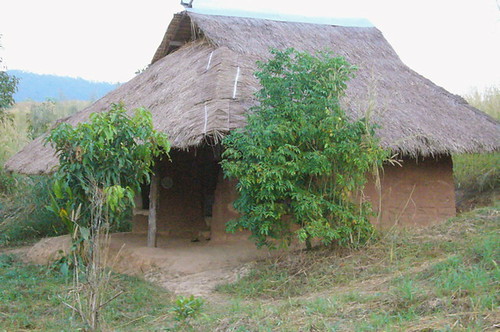
Here's what my room looks like...it's very nice!
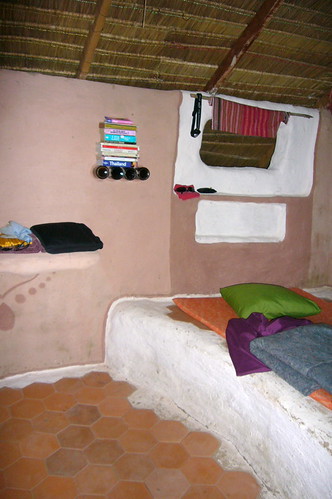
Here's the bathroom, also made of adobe and thatch...
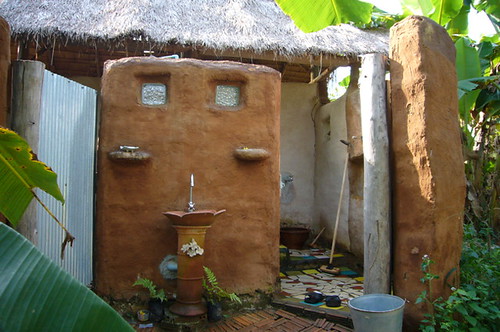
Here's a cob oven at the neighbors' place. I just had some bread from this oven and it was great.
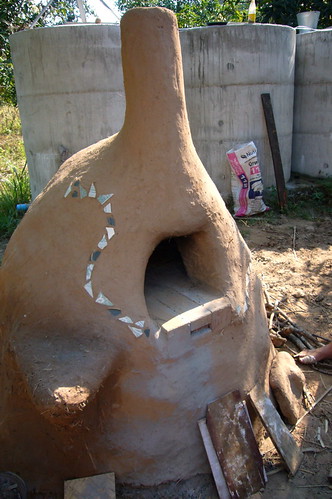
Here's one of Pun Pun's many gardens...

Sunset over the rice paddies and Baan Mae Jo.


Here's what my room looks like...it's very nice!

Here's the bathroom, also made of adobe and thatch...

Here's a cob oven at the neighbors' place. I just had some bread from this oven and it was great.

Here's one of Pun Pun's many gardens...

Sunset over the rice paddies and Baan Mae Jo.

Beginnings at Pun Pun
My internship has begun at Pun Pun (means “thousand varieties”) farm in northern Thailand. We are about 35 miles north of Chiang Mai city in a small farming village called Baan Mae Jo. It’s beautiful here – much calmer, quieter and cleaner than Chiang Mai.
Pun Pun is an organic farm and seed bank that began a little more than three years ago. It was started by Jo Jandai, a Thai from the northeastern part of the country, and Peggy Reents, originally from Colorado. Peggy and Jo are married and have a two-year-old son, Tahn, who is already an energetic adobe builder.
Jo has more than ten years’ experience in earthen building (adobe, cob, wattle and daub, etc.) but is most passionate about Pun Pun’s seed saving activities. Peggy and Jo have traveled all over Thailand doing building projects, have held many workshops here at Pun Pun, and have helped numerous friends and neighbors with their projects. During the internship we will be building a yoga and meditation center primarily out of adobe, but using an array of earthen and natural building techniques as well.
Besides Peggy and Jo (and Tahn!), there are about eight full-time community members (mostly Thais) and about an equal number of long-term guests (a mix of Thais and Westerners). This group includes myself and my colleagues, a total of five winter interns. Many guests and visitors regularly come and go, including people from the village.
Since Pun Pun’s establishment, two neighboring communities have sprung up working on similar activities. One is, for the time being, called Baan Thai (“Thai House”), which is a group of about twelve North Americans organized by a previous Pun Pun intern to create a kind of permaculture laboratory on about ten acres of land adjacent to Pun Pun. The other is called You Sabai (“To relax and feel healthy”) and is run by a Thai couple who are writers and are working to publish a “lifestyle” magazine profiling sustainable living. They adapted some Pun Pun building techniques to create a very comfortable coffee shop at the top of the hill overlooking the other farms, and are planning to host retreat groups for Thai massage, meditation, etc.
Building workshops have provided the income for Pun Pun, as well as most of the structures on the farm, although building is not the main focus of Pun Pun as an organization. Currently, our planet is experiencing the largest mass extinction of species in its history (including the period after the asteroid impact in Mexico that killed off the dinosaurs). The rate of species dieoff seems to be accelerating, as the Living Planet Index shows about a 30% drop in the number of vertebrate species since 1970. Recognizing this precipitous decline in biodiversity, Pun Pun’s principle mission has been to create a seed center to collect rare, indigenous and beneficial seeds from around the region and world, propagate them at the farm, and share them through a network of farmers in Thailand, and in this way counter some of the destructive trends of biodiversity loss in food crops. Pun Pun has thus become an active learning center that hosts workshops, internships and trainings on sustainable living practices. Westerners pay tuition to attend these programs, which allows Thais and people from other developing countries to attend for free.
The success in farming that Pun Pun exhibits after only three years is a testament to the efficacy of permaculture methods. Before Peggy and Jo bought the land it had been forest which was clear cut to plant a few crops of corn. Tropical soils in general are very depleted in nutrients, and so only a very few harvests of corn could be obtained and then the land was nearly dead and thorny grasses took over. The people of the Baan Mae Jo village though Peggy and Jo were crazy for buying this land and trying to farm here: it’s a hilly site with sandy soil and many rocks -- it sold cheap since the owner believed it was nearly worthless for farming.
Immediately Peggy, Jo and a few friends began planting several varieties of banana trees, which grow easily and rapidly in these conditions and produce a good mulch of banana leaves that add nutrition to the soil. Skillful organic gardening since the beginning has produced a wide variety of edible plants that, including rice from Pun Pun’s paddy area, comprise about half of all food eaten by the community. Part of my internship is concerned with establishing some new garden beds as well as attending existing gardens; I will provide subsequent detailed posts describing this work and all the amazing and delicious foods that are growing here.
Pun Pun is an organic farm and seed bank that began a little more than three years ago. It was started by Jo Jandai, a Thai from the northeastern part of the country, and Peggy Reents, originally from Colorado. Peggy and Jo are married and have a two-year-old son, Tahn, who is already an energetic adobe builder.
Jo has more than ten years’ experience in earthen building (adobe, cob, wattle and daub, etc.) but is most passionate about Pun Pun’s seed saving activities. Peggy and Jo have traveled all over Thailand doing building projects, have held many workshops here at Pun Pun, and have helped numerous friends and neighbors with their projects. During the internship we will be building a yoga and meditation center primarily out of adobe, but using an array of earthen and natural building techniques as well.
Besides Peggy and Jo (and Tahn!), there are about eight full-time community members (mostly Thais) and about an equal number of long-term guests (a mix of Thais and Westerners). This group includes myself and my colleagues, a total of five winter interns. Many guests and visitors regularly come and go, including people from the village.
Since Pun Pun’s establishment, two neighboring communities have sprung up working on similar activities. One is, for the time being, called Baan Thai (“Thai House”), which is a group of about twelve North Americans organized by a previous Pun Pun intern to create a kind of permaculture laboratory on about ten acres of land adjacent to Pun Pun. The other is called You Sabai (“To relax and feel healthy”) and is run by a Thai couple who are writers and are working to publish a “lifestyle” magazine profiling sustainable living. They adapted some Pun Pun building techniques to create a very comfortable coffee shop at the top of the hill overlooking the other farms, and are planning to host retreat groups for Thai massage, meditation, etc.
Building workshops have provided the income for Pun Pun, as well as most of the structures on the farm, although building is not the main focus of Pun Pun as an organization. Currently, our planet is experiencing the largest mass extinction of species in its history (including the period after the asteroid impact in Mexico that killed off the dinosaurs). The rate of species dieoff seems to be accelerating, as the Living Planet Index shows about a 30% drop in the number of vertebrate species since 1970. Recognizing this precipitous decline in biodiversity, Pun Pun’s principle mission has been to create a seed center to collect rare, indigenous and beneficial seeds from around the region and world, propagate them at the farm, and share them through a network of farmers in Thailand, and in this way counter some of the destructive trends of biodiversity loss in food crops. Pun Pun has thus become an active learning center that hosts workshops, internships and trainings on sustainable living practices. Westerners pay tuition to attend these programs, which allows Thais and people from other developing countries to attend for free.
The success in farming that Pun Pun exhibits after only three years is a testament to the efficacy of permaculture methods. Before Peggy and Jo bought the land it had been forest which was clear cut to plant a few crops of corn. Tropical soils in general are very depleted in nutrients, and so only a very few harvests of corn could be obtained and then the land was nearly dead and thorny grasses took over. The people of the Baan Mae Jo village though Peggy and Jo were crazy for buying this land and trying to farm here: it’s a hilly site with sandy soil and many rocks -- it sold cheap since the owner believed it was nearly worthless for farming.
Immediately Peggy, Jo and a few friends began planting several varieties of banana trees, which grow easily and rapidly in these conditions and produce a good mulch of banana leaves that add nutrition to the soil. Skillful organic gardening since the beginning has produced a wide variety of edible plants that, including rice from Pun Pun’s paddy area, comprise about half of all food eaten by the community. Part of my internship is concerned with establishing some new garden beds as well as attending existing gardens; I will provide subsequent detailed posts describing this work and all the amazing and delicious foods that are growing here.
Friday, December 08, 2006
Let's play a game
Let’s play a game called “What have I got in my rucksack?”
Well, it’s not much of a game really since I am going to tell you the answer. Now, I could go through the whole list:
three short-sleeved cotton t-shirts
two long-sleeved thermal shits
two pairs of Carhartt dungarees
one pair of hiking shorts
three pairs of wool-synthetic blend socks
three pairs of boxer shorts
first aid kit
headlamp
two toothbrushes and one tube of toothpaste, soap and shampoo
malaria and diarrhea medication
laptop computer and associated hardware
one pair of Chaco sandals, one pair of sturdy hiking/working shoes
one Nalgene 1 L water bottle and iodine tablets for purification
one rain jacket
one Leatherman multi-tool
and so on…
But that’s all very mundane, and what I really want to get to are the books I have brought along with me and acquired since arriving in Thailand.
I should mention at the outset that I am well acquainted with the first and second cardinal rules of backpacking, which specify that one ought to minimize both the number of articles in one’s pack as well as the weight of things being carried, and that carrying around a selection of several books tends to run one afoul of both of these rules. But for the past few years I have contracted a case of chronic book acquisition syndrome and it would be presumptuous to expect that an extended journey around Southeast Asia would produce an immediate cure for this condition.
So let’s begin our game of “What books am I lugging around in my rucksack?”
The first two books, and I mention them first to get them out of the way, for I doubt that they truly count against the total tally in this game, are from the Lonely Planet series and they are a guide to Thailand as well as a Thai phrasebook.
The phrasebook is small enough to fit comfortably in the front pocket of my Carhartt dungarees, and owing to this physical characteristic of the book I assumed, wrongly, that its contents would be readily mastered on the plane ride from San Francisco to Asia. It turns out that Thai is a very difficult language, especially for Westerners, not least because it is tonal in nature. This means that there are about six different meanings for any one given word based upon how it is spoken -- with an up or down inflection, an accent here or there, and other such subtle differences. Thus far I have nearly mastered all of two phrases: “Sa wat dii, KAP” which means “Hello (I am a man)”, and, “kap kun KAP” which means “Thank you (I am a man).” The “KAP” at the end of the phrases is the part signifying my masculinity. If I were a woman, I would substitute “KAA.” I’m not sure why it is important to continually assert one’s gender during the course of a common conversation, but I am a guest in a foreign land so I play along respectfully.
With the requisite Lonely Planet guides out of the way, I will give 5 Baht (about $0.15) to the first person who can guess one of the books in my traveling collection.
Congratulations! Of course I brought my haggard and dog-eared copy of Zen and the Art of Motorcycle Maintenance by Robert Pirsig. A 5 Baht bonus will be awarded if you guessed that I brought along the sequel to this book, entitled Lila, as well. If I get through ZAMM before New Year’s that makes for six times (I think) that I have read that book this year. It may be the most important book ever. I’m not sure about this, but all the same you should run out to your local used bookstore and buy a copy right now and read it, over and over again if necessary, until you have sufficiently absorbed its messages. I predict that it will either cause a complete revolution in your life and the way you think about yourself and the world, or you will get a little way into it and decide “hey, this guy’s really mean to his kid, and he’s kind of an asshole to his friends as well”, and you’ll put the book aside and maybe forget about it completely. Then one day, someone in your life, probably me, will bring it up and say, “have you read Zen and the Art…” and you will say, “Oh yeah, I think I read that, maybe in college or high school, I forget, wasn’t he really mean to his son or something?” and I will sigh and suggest you revisit it. And then maybe the whole process will begin again.
Enough! On with the game. I can’t spend that much writing about one book, important a book though it is.
What to mention next? OK, how about E. M. Forster’s A Passage to India. I don’t know anything about this one -- it was given to me by my good friend Mary the night before I left for Asia. It looks interesting, and I am eventually going to India so maybe it has some important stuff I’ll need to know before I get there.
Next is a volume from the German Library Series of two of Herman Hesse’s stories: Siddhartha, and Demian. I read all of Siddhartha on the plane from Taipei to Bangkok and it blew my mind. I always read myself into books, but this one was really about me, man! Really! This is another one to run out and buy right away. Maybe it’s about you too. Or maybe not, but if you read it you might understand me better. (I’m sure that understanding me is a very high priority for most of you since I am such an important person in all of your lives.) I finished Demian last night and it was very good as well.
The next book represents a very high mountain to scale indeed: James Joyce’s A Portrait of the Artist as a Young Man. I really want to get Joyce; perhaps I am asking too much of myself. I remember in college when I was taking an advanced physics course on subatomic particles and the professor told us that the name “quarks” came from a James Joyce novel, Finnegan’s Wake. So of course I ran right out and bought it, read the first three pages, closed the book and put it on my bookshelf and there it has remained since.
Next (this is beginning to seem crazy isn’t it? To carry all these books around! Well, wait, it gets better. We still haven’t finished the books I brought with me. After that come the books I have bought since I arrived…)
Next is The Unsettling of America by Wendell Berry. I am very excited to read this, since I’ve read many of Berry’s essays and he is my hero. I’m getting more and more into this farming thing, and here we have a brilliant farmer, philosopher, essayist and poet, and fellow Appalachian to boot! What could be better?
And finally, of the books I brought with me from California, well, it’s a section of a book really, photocopied. This one was hard bound and I only wanted certain parts so I managed to make copies just before I left. The excerpts are from a biography of Werner Erhard by William Bartley III. Werner Erhard, nee Jack Rosenberg, is the guy who invented est, the controversial philosophical training seminar that began in San Francisco in the 1970’s. The current form of est still going on is called the Landmark Forum, of which I took two courses this year. I’m still trying to work out just what the hell happened to me in the Landmark forum, and Bartley’s biography of Erhard goes lengths to expound upon the philosophy that underlies est and Landmark. Landmark is kind of like a course in practical Existentialism, and also draws heavily on Zen Buddhism. I know people think Landmark is creepy or cultish, but it really helped me and is continuing to do so, so I am very keen to understand just how it works and to develop a practice of my own for increasingly being “powerfully engaged with reality,” as they say.
OK, now on to the books that I have added to my traveling collection since I arrived in Thailand. (One thing about touristy Chiang Mai is that there are a bunch of great used bookshops, because truly clever backpackers, unlike me, tend to unload books rather than accumulate them.)
In keeping with my burgeoning interest in Existentialism, I picked up a copy of Sartre’s Nausea. I’ve started it, but I’m not sure if I will like it, or even get it. I know Sartre’s the apotheosis of Existentialism and if I ever want to call myself an Existentialist I have to get him, but I don’t know if I can groove on Nausea. (Hey, did anyone get that joke about “calling myself an Existentialist”? What could be more un-Existentialist than to shoehorn one’s self, whatever that is, into some reductionist conceptual pigeonhole?) Anyway, maybe I’ll end up doing an end-run around Sartre and go right back to Nietzsche and Kierkegaard and Dostoevsky and figure it out myself, eminent French philosophers aside.
OK, two more and we’re done. At least until the bookshops open tomorrow morning.
Nope, I lied, I see there are three more.
One: A history of Western philosophy by Bertrand Russell entitled The Wisdom of the West.
Two: A collection of lectures by Buddhist scholar Alan Watts entitled Buddhism: The Religion of No-Religion.
Three: Being Peace, a collection of essays by the Vietnamese Buddhist monk Thich Nhat Hahn.
Well, that’s it. Apparently I’m interested in philosophy. In fact this is so. This winter, to the extent that I am anything, I am a farmer and a philosopher. I know very, very little about either farming or philosophy. I am here to learn.
Well, it’s not much of a game really since I am going to tell you the answer. Now, I could go through the whole list:
three short-sleeved cotton t-shirts
two long-sleeved thermal shits
two pairs of Carhartt dungarees
one pair of hiking shorts
three pairs of wool-synthetic blend socks
three pairs of boxer shorts
first aid kit
headlamp
two toothbrushes and one tube of toothpaste, soap and shampoo
malaria and diarrhea medication
laptop computer and associated hardware
one pair of Chaco sandals, one pair of sturdy hiking/working shoes
one Nalgene 1 L water bottle and iodine tablets for purification
one rain jacket
one Leatherman multi-tool
and so on…
But that’s all very mundane, and what I really want to get to are the books I have brought along with me and acquired since arriving in Thailand.
I should mention at the outset that I am well acquainted with the first and second cardinal rules of backpacking, which specify that one ought to minimize both the number of articles in one’s pack as well as the weight of things being carried, and that carrying around a selection of several books tends to run one afoul of both of these rules. But for the past few years I have contracted a case of chronic book acquisition syndrome and it would be presumptuous to expect that an extended journey around Southeast Asia would produce an immediate cure for this condition.
So let’s begin our game of “What books am I lugging around in my rucksack?”
The first two books, and I mention them first to get them out of the way, for I doubt that they truly count against the total tally in this game, are from the Lonely Planet series and they are a guide to Thailand as well as a Thai phrasebook.
The phrasebook is small enough to fit comfortably in the front pocket of my Carhartt dungarees, and owing to this physical characteristic of the book I assumed, wrongly, that its contents would be readily mastered on the plane ride from San Francisco to Asia. It turns out that Thai is a very difficult language, especially for Westerners, not least because it is tonal in nature. This means that there are about six different meanings for any one given word based upon how it is spoken -- with an up or down inflection, an accent here or there, and other such subtle differences. Thus far I have nearly mastered all of two phrases: “Sa wat dii, KAP” which means “Hello (I am a man)”, and, “kap kun KAP” which means “Thank you (I am a man).” The “KAP” at the end of the phrases is the part signifying my masculinity. If I were a woman, I would substitute “KAA.” I’m not sure why it is important to continually assert one’s gender during the course of a common conversation, but I am a guest in a foreign land so I play along respectfully.
With the requisite Lonely Planet guides out of the way, I will give 5 Baht (about $0.15) to the first person who can guess one of the books in my traveling collection.
Congratulations! Of course I brought my haggard and dog-eared copy of Zen and the Art of Motorcycle Maintenance by Robert Pirsig. A 5 Baht bonus will be awarded if you guessed that I brought along the sequel to this book, entitled Lila, as well. If I get through ZAMM before New Year’s that makes for six times (I think) that I have read that book this year. It may be the most important book ever. I’m not sure about this, but all the same you should run out to your local used bookstore and buy a copy right now and read it, over and over again if necessary, until you have sufficiently absorbed its messages. I predict that it will either cause a complete revolution in your life and the way you think about yourself and the world, or you will get a little way into it and decide “hey, this guy’s really mean to his kid, and he’s kind of an asshole to his friends as well”, and you’ll put the book aside and maybe forget about it completely. Then one day, someone in your life, probably me, will bring it up and say, “have you read Zen and the Art…” and you will say, “Oh yeah, I think I read that, maybe in college or high school, I forget, wasn’t he really mean to his son or something?” and I will sigh and suggest you revisit it. And then maybe the whole process will begin again.
Enough! On with the game. I can’t spend that much writing about one book, important a book though it is.
What to mention next? OK, how about E. M. Forster’s A Passage to India. I don’t know anything about this one -- it was given to me by my good friend Mary the night before I left for Asia. It looks interesting, and I am eventually going to India so maybe it has some important stuff I’ll need to know before I get there.
Next is a volume from the German Library Series of two of Herman Hesse’s stories: Siddhartha, and Demian. I read all of Siddhartha on the plane from Taipei to Bangkok and it blew my mind. I always read myself into books, but this one was really about me, man! Really! This is another one to run out and buy right away. Maybe it’s about you too. Or maybe not, but if you read it you might understand me better. (I’m sure that understanding me is a very high priority for most of you since I am such an important person in all of your lives.) I finished Demian last night and it was very good as well.
The next book represents a very high mountain to scale indeed: James Joyce’s A Portrait of the Artist as a Young Man. I really want to get Joyce; perhaps I am asking too much of myself. I remember in college when I was taking an advanced physics course on subatomic particles and the professor told us that the name “quarks” came from a James Joyce novel, Finnegan’s Wake. So of course I ran right out and bought it, read the first three pages, closed the book and put it on my bookshelf and there it has remained since.
Next (this is beginning to seem crazy isn’t it? To carry all these books around! Well, wait, it gets better. We still haven’t finished the books I brought with me. After that come the books I have bought since I arrived…)
Next is The Unsettling of America by Wendell Berry. I am very excited to read this, since I’ve read many of Berry’s essays and he is my hero. I’m getting more and more into this farming thing, and here we have a brilliant farmer, philosopher, essayist and poet, and fellow Appalachian to boot! What could be better?
And finally, of the books I brought with me from California, well, it’s a section of a book really, photocopied. This one was hard bound and I only wanted certain parts so I managed to make copies just before I left. The excerpts are from a biography of Werner Erhard by William Bartley III. Werner Erhard, nee Jack Rosenberg, is the guy who invented est, the controversial philosophical training seminar that began in San Francisco in the 1970’s. The current form of est still going on is called the Landmark Forum, of which I took two courses this year. I’m still trying to work out just what the hell happened to me in the Landmark forum, and Bartley’s biography of Erhard goes lengths to expound upon the philosophy that underlies est and Landmark. Landmark is kind of like a course in practical Existentialism, and also draws heavily on Zen Buddhism. I know people think Landmark is creepy or cultish, but it really helped me and is continuing to do so, so I am very keen to understand just how it works and to develop a practice of my own for increasingly being “powerfully engaged with reality,” as they say.
OK, now on to the books that I have added to my traveling collection since I arrived in Thailand. (One thing about touristy Chiang Mai is that there are a bunch of great used bookshops, because truly clever backpackers, unlike me, tend to unload books rather than accumulate them.)
In keeping with my burgeoning interest in Existentialism, I picked up a copy of Sartre’s Nausea. I’ve started it, but I’m not sure if I will like it, or even get it. I know Sartre’s the apotheosis of Existentialism and if I ever want to call myself an Existentialist I have to get him, but I don’t know if I can groove on Nausea. (Hey, did anyone get that joke about “calling myself an Existentialist”? What could be more un-Existentialist than to shoehorn one’s self, whatever that is, into some reductionist conceptual pigeonhole?) Anyway, maybe I’ll end up doing an end-run around Sartre and go right back to Nietzsche and Kierkegaard and Dostoevsky and figure it out myself, eminent French philosophers aside.
OK, two more and we’re done. At least until the bookshops open tomorrow morning.
Nope, I lied, I see there are three more.
One: A history of Western philosophy by Bertrand Russell entitled The Wisdom of the West.
Two: A collection of lectures by Buddhist scholar Alan Watts entitled Buddhism: The Religion of No-Religion.
Three: Being Peace, a collection of essays by the Vietnamese Buddhist monk Thich Nhat Hahn.
Well, that’s it. Apparently I’m interested in philosophy. In fact this is so. This winter, to the extent that I am anything, I am a farmer and a philosopher. I know very, very little about either farming or philosophy. I am here to learn.
What I would do if I wasn't in Thailand...
One thing for sure would be to attend the Eco-Farm conference in Pacific Grove, CA this January.
Trek through the hill country
Earlier this week Beth and I took a three-day trek through the hill provinces north of Chiang Mai. This trip was set up through 3rd Eye Travel, an adventure touring company run by a wonderful Thai man named Dtaw who is friends with the couple that have the farm I will be working at through the winter.
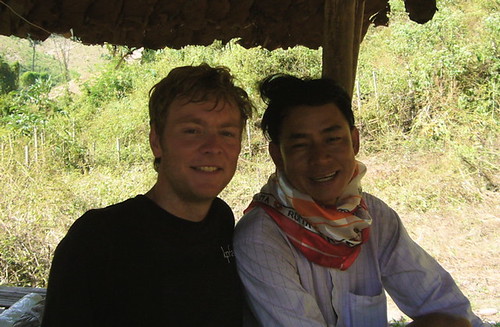
Dtaw introduced us to Jatoo, our guide for the trip. Jatoo is originally from a Karen hill tribe village far in the north of Thailand closer to Chiang Rai and the border with Burma. Jatoo speaks several languages including Thai, English and many of the hill tribe dialects.
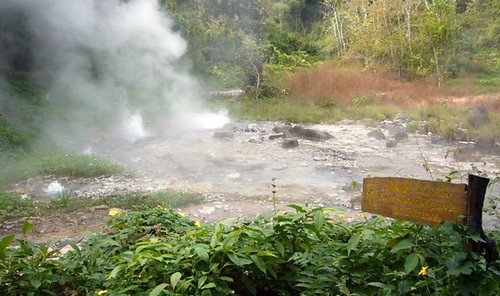
We began the trek at a Thai National Park and wildlife preserve that features a geyser geothermal area. Jatoo had told us that we would start the trek at a hot springs. We left Chiang Mai in the morning and drove for a few hours to begin the hiking around noon. It was getting on to the hottest part of the day and I knew we had many miles of steep climbing ahead through jungle into the mountain provinces, so I was not all that excited to start the trip at a hot springs. A few weeks ago when I was high in the mountains of Idaho and the wind was cold and the sky was pregnant with snow clouds I welcomed the opportunity to soak in hot springs. But in tropical Thailand? A hot spring dip seemed a bit unwelcome.
So you can imagine my surprise, and relief, when I saw jets of boiling water shooting into the air. Of course we wouldn’t be expected to soak in this – when Jatoo had said hot spring he had meant really really hot spring. “Like Yellowstone,” he said. Indeed.
This centipede is nearly 1 foot long, and poisonous.

A termite mound.

A very large spider...
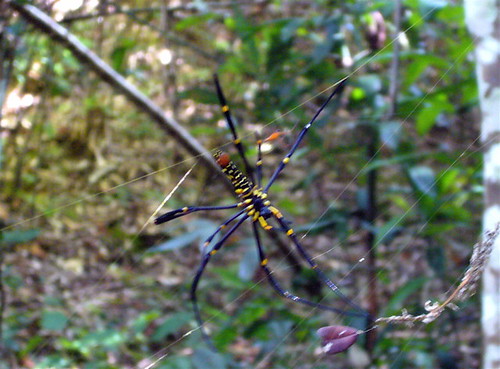
After visiting the geysers we hiked deep into the jungle. Jatoo pointed out all sorts of interesting plants, trees and insects along the way. We arrived in time for dinner at a Karen hill tribe village. The buildings here are made of wood and bamboo, with thatch roofs. Several of the houses had solar cells with batteries and one or two fluorescent bulbs for lighting. These were given to the hill tribes by the government if the tribes promised not to engage in the opium trade.
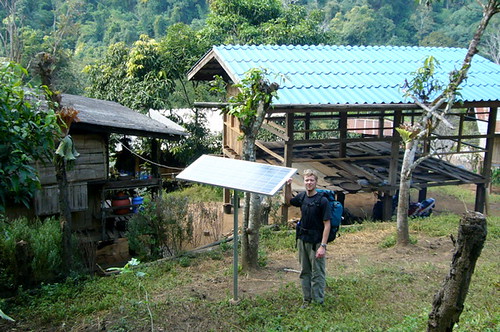
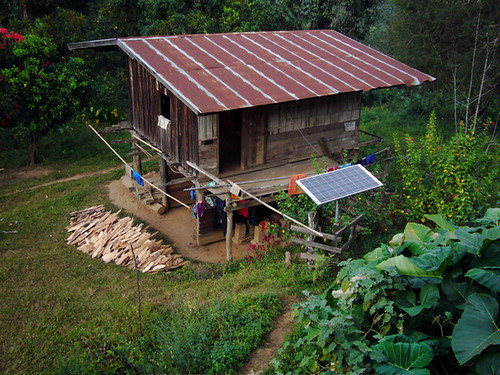
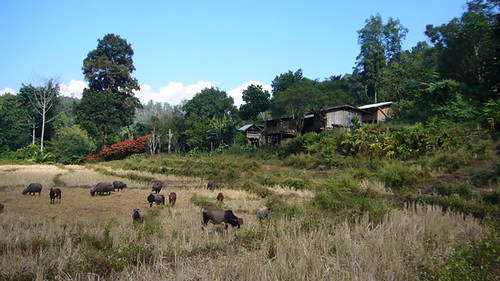
The hill tribes of northern Thailand are one of the last remaining examples in the world of genuine subsistence living. This particular tribe provides for over 80% of its needs from its small farm and the surrounding jungle. The Karen village we stayed in cannot be reached by car -- only recently have they acquired a motorbike, which mainly the young boys use to go into the tiny town several miles away for socializing.
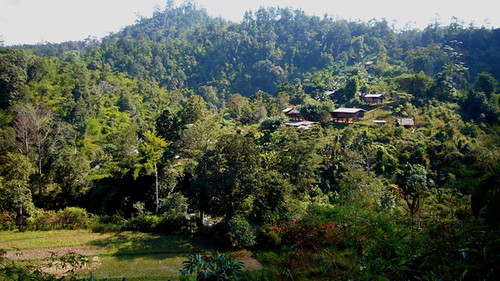
Many of the tribes in the area are so small – consisting of only a few families – that the government will provide for only one school for several villages. Sometimes the children hike five or ten miles to school, and stay over many nights during the week.
Where we slept at the Karen village. The mosquito nets were unnecessary since it is the dry season. We slept on thin padded mattresses that were quite comfortable, and were awakened (early!) by the roosters.
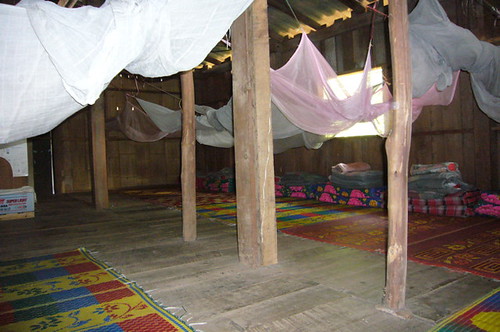
Although the villages we visited are very “poor” in our sense of the word, the quality of life is not bad, if it is rather hard-scrabble. Diets consist of rice and vegetable as well as meat from chickens, pigs, cows and water buffalos – they thought we were a bit odd for being vegetarian. Also they eat wild rodents like squirrels and field mice, as well as deer and other wild mammals that inhabit the jungles.
Water buffaloes.
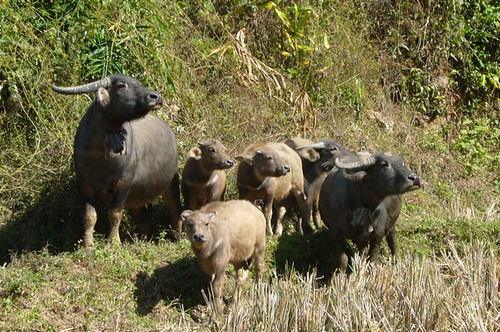
One Karen villager demonstrated an ingenious field mouse trap for me. It was made of a short (about 6 inches long) section of bamboo, which is hollow, with a long piece of stiff reed attached resembling a bow. A loop of twine is concealed in the hollow of the bamboo, and a catch mechanism holds the reed bow in a taut bent position. The trap is loaded with a bit of rice; when the mouse goes to eat the rice it trips the catch and the bow snaps the loop of twine around the mouse’s head and it’s caught. It’s probably hard for you to imagine the device from this description, but I assure you it’s very clever.
Banana trees of several varieties proliferate wildly in the village and surrounding jungle, as well as dragon fruit, mangoes, star-apples and papayas. We saw gardens growing many types of beans, peppers and all sorts of herbs and spices for cooking such as lemon grass and basil.
On the second day we hiked long across two steep mountain ridges and arrived mid-afternoon at an elephant camp along the Mae Taeng river. Our tough hiking through the hot jungle was rewarded with a lazy ride down the river on the back of an elephant to our destination for the evening: a Lahu hill tribe village. No motor vehicles of any kind can reach this village – transportation is only via foot trail or the river. The Lahus have historically been associated with the opium trade from Burma, and so as “punishment” by the government were given no solar cells. They did not seem the worse for it though.
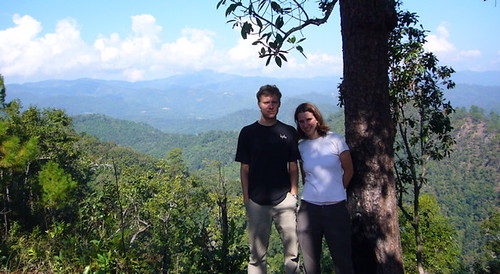
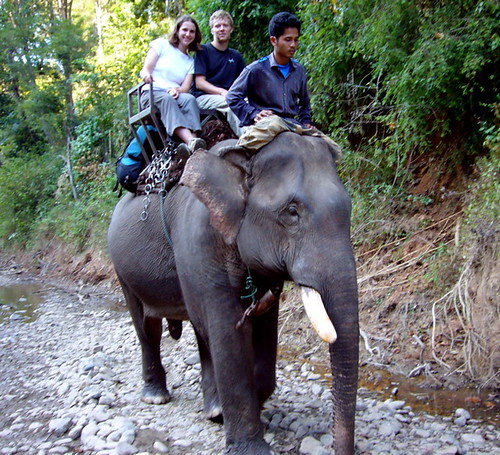
Jatoo says the Lahu are his favorites, since they are so friendly and polite. He mentioned another tribe that has a reputation for being arrogant – the elitists of the hill tribes I suppose. I don’t remember their name, but it’s just as well since I don’t want to be accused libelous speech towards the hill tribes.
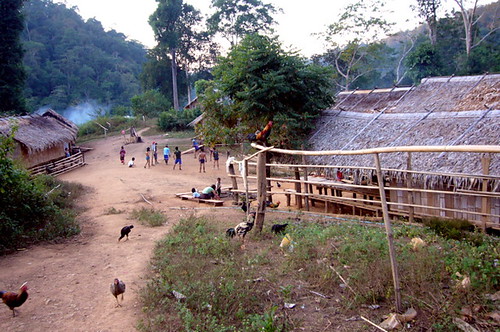
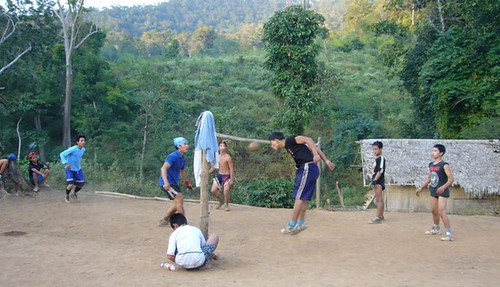
Pictured are some young boys playing the Thai national game – takraw – a kind of volleyball using only the feet and head. They are quite good and as such I can’t understand why Thailand is typically so poor at soccer. All villages have takraw courts installed by the government health department as a campaign to promote exercise.
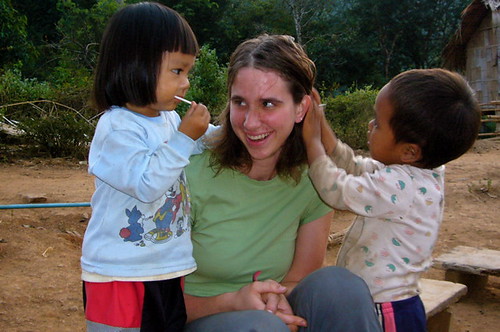
The Lahu children took a real liking to Beth, as you can see here. And I’ve tried to photograph our dinner, but I didn’t do it justice. Jatoo was an excellent cook – even cooking for vegetarians, which he found odd – and the food looked, smelled and tasted superb. We had rice grown in the village paddies, tofu and vegetables in a curry with coconut milk and cashews, as well as an omelete made with fresh green chili paste that Jatoo prepared in a mortar and pestle.
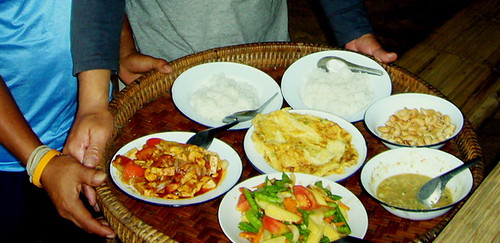
For the final day of the trek we rafted through some mild whitewater rapids on a bamboo raft made by the Lahu villagers. These rafts are about 30 feet long and four feet wide, made of 15 – 20 long thick bamboo poles lashed together with rattan reeds. Near the front of the raft they constructed a tri-pod out of bamboo poles to hold our backpacks up out of the water. As we started down the river, all of the admonitions about standing up in the boat went out the window – there was nowhere to sit and besides we had to stand to use long bamboo poles to guide the raft between rocks and around the many bends of the river.
In the mid-afternoon we reached the pull-out, had lunch, and were picked up by Dtaw and dropped off at his company’s river camp for a snack of coffee, papaya and dragon fruit and to rest a while. His river camp has a few bamboo hut dormitories for overnight treks as well as a kind of cabana hang-out/eating place. It’s all open-air and has a spectacular view of the river below and the rice field and huts of a Thai village along the foothills across the way. It’s basically paradise. We sat in hammocks in the shade and enjoyed the fruit and read Thai travel magazines and conversed for a while. Then Dtaw drove us back to Chiang Mai, with a detour to the Pun Pun farm where I will be living and working this winter.
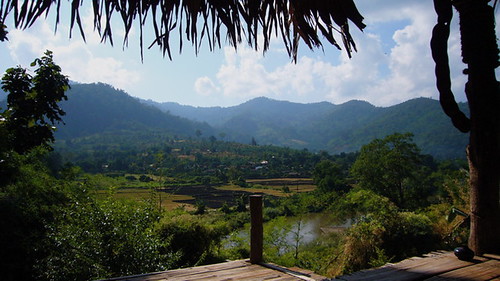
If Dtaw’s river camp was paradise, then Pun Pun is like some kind of upper level of paradise. I got a brief tour and met some of the folks there. I’m leaving Chiang Mai Saturday December 9 to move up there – as I get settled in I’ll take lots of pictures and try to write some descriptions about how wonderful it is. I’m very excited to share it with you!

Dtaw introduced us to Jatoo, our guide for the trip. Jatoo is originally from a Karen hill tribe village far in the north of Thailand closer to Chiang Rai and the border with Burma. Jatoo speaks several languages including Thai, English and many of the hill tribe dialects.

We began the trek at a Thai National Park and wildlife preserve that features a geyser geothermal area. Jatoo had told us that we would start the trek at a hot springs. We left Chiang Mai in the morning and drove for a few hours to begin the hiking around noon. It was getting on to the hottest part of the day and I knew we had many miles of steep climbing ahead through jungle into the mountain provinces, so I was not all that excited to start the trip at a hot springs. A few weeks ago when I was high in the mountains of Idaho and the wind was cold and the sky was pregnant with snow clouds I welcomed the opportunity to soak in hot springs. But in tropical Thailand? A hot spring dip seemed a bit unwelcome.
So you can imagine my surprise, and relief, when I saw jets of boiling water shooting into the air. Of course we wouldn’t be expected to soak in this – when Jatoo had said hot spring he had meant really really hot spring. “Like Yellowstone,” he said. Indeed.
This centipede is nearly 1 foot long, and poisonous.

A termite mound.

A very large spider...

After visiting the geysers we hiked deep into the jungle. Jatoo pointed out all sorts of interesting plants, trees and insects along the way. We arrived in time for dinner at a Karen hill tribe village. The buildings here are made of wood and bamboo, with thatch roofs. Several of the houses had solar cells with batteries and one or two fluorescent bulbs for lighting. These were given to the hill tribes by the government if the tribes promised not to engage in the opium trade.



The hill tribes of northern Thailand are one of the last remaining examples in the world of genuine subsistence living. This particular tribe provides for over 80% of its needs from its small farm and the surrounding jungle. The Karen village we stayed in cannot be reached by car -- only recently have they acquired a motorbike, which mainly the young boys use to go into the tiny town several miles away for socializing.

Many of the tribes in the area are so small – consisting of only a few families – that the government will provide for only one school for several villages. Sometimes the children hike five or ten miles to school, and stay over many nights during the week.
Where we slept at the Karen village. The mosquito nets were unnecessary since it is the dry season. We slept on thin padded mattresses that were quite comfortable, and were awakened (early!) by the roosters.

Although the villages we visited are very “poor” in our sense of the word, the quality of life is not bad, if it is rather hard-scrabble. Diets consist of rice and vegetable as well as meat from chickens, pigs, cows and water buffalos – they thought we were a bit odd for being vegetarian. Also they eat wild rodents like squirrels and field mice, as well as deer and other wild mammals that inhabit the jungles.
Water buffaloes.

One Karen villager demonstrated an ingenious field mouse trap for me. It was made of a short (about 6 inches long) section of bamboo, which is hollow, with a long piece of stiff reed attached resembling a bow. A loop of twine is concealed in the hollow of the bamboo, and a catch mechanism holds the reed bow in a taut bent position. The trap is loaded with a bit of rice; when the mouse goes to eat the rice it trips the catch and the bow snaps the loop of twine around the mouse’s head and it’s caught. It’s probably hard for you to imagine the device from this description, but I assure you it’s very clever.
Banana trees of several varieties proliferate wildly in the village and surrounding jungle, as well as dragon fruit, mangoes, star-apples and papayas. We saw gardens growing many types of beans, peppers and all sorts of herbs and spices for cooking such as lemon grass and basil.
On the second day we hiked long across two steep mountain ridges and arrived mid-afternoon at an elephant camp along the Mae Taeng river. Our tough hiking through the hot jungle was rewarded with a lazy ride down the river on the back of an elephant to our destination for the evening: a Lahu hill tribe village. No motor vehicles of any kind can reach this village – transportation is only via foot trail or the river. The Lahus have historically been associated with the opium trade from Burma, and so as “punishment” by the government were given no solar cells. They did not seem the worse for it though.


Jatoo says the Lahu are his favorites, since they are so friendly and polite. He mentioned another tribe that has a reputation for being arrogant – the elitists of the hill tribes I suppose. I don’t remember their name, but it’s just as well since I don’t want to be accused libelous speech towards the hill tribes.


Pictured are some young boys playing the Thai national game – takraw – a kind of volleyball using only the feet and head. They are quite good and as such I can’t understand why Thailand is typically so poor at soccer. All villages have takraw courts installed by the government health department as a campaign to promote exercise.

The Lahu children took a real liking to Beth, as you can see here. And I’ve tried to photograph our dinner, but I didn’t do it justice. Jatoo was an excellent cook – even cooking for vegetarians, which he found odd – and the food looked, smelled and tasted superb. We had rice grown in the village paddies, tofu and vegetables in a curry with coconut milk and cashews, as well as an omelete made with fresh green chili paste that Jatoo prepared in a mortar and pestle.

For the final day of the trek we rafted through some mild whitewater rapids on a bamboo raft made by the Lahu villagers. These rafts are about 30 feet long and four feet wide, made of 15 – 20 long thick bamboo poles lashed together with rattan reeds. Near the front of the raft they constructed a tri-pod out of bamboo poles to hold our backpacks up out of the water. As we started down the river, all of the admonitions about standing up in the boat went out the window – there was nowhere to sit and besides we had to stand to use long bamboo poles to guide the raft between rocks and around the many bends of the river.
In the mid-afternoon we reached the pull-out, had lunch, and were picked up by Dtaw and dropped off at his company’s river camp for a snack of coffee, papaya and dragon fruit and to rest a while. His river camp has a few bamboo hut dormitories for overnight treks as well as a kind of cabana hang-out/eating place. It’s all open-air and has a spectacular view of the river below and the rice field and huts of a Thai village along the foothills across the way. It’s basically paradise. We sat in hammocks in the shade and enjoyed the fruit and read Thai travel magazines and conversed for a while. Then Dtaw drove us back to Chiang Mai, with a detour to the Pun Pun farm where I will be living and working this winter.

If Dtaw’s river camp was paradise, then Pun Pun is like some kind of upper level of paradise. I got a brief tour and met some of the folks there. I’m leaving Chiang Mai Saturday December 9 to move up there – as I get settled in I’ll take lots of pictures and try to write some descriptions about how wonderful it is. I’m very excited to share it with you!
Subscribe to:
Comments (Atom)

